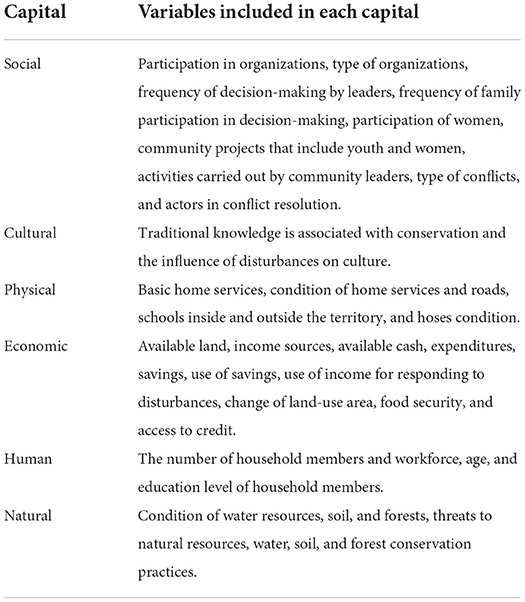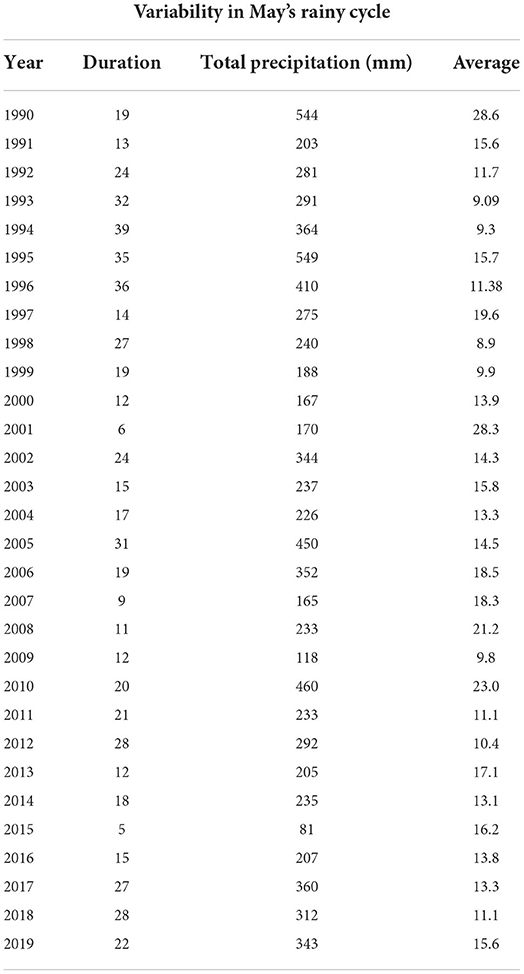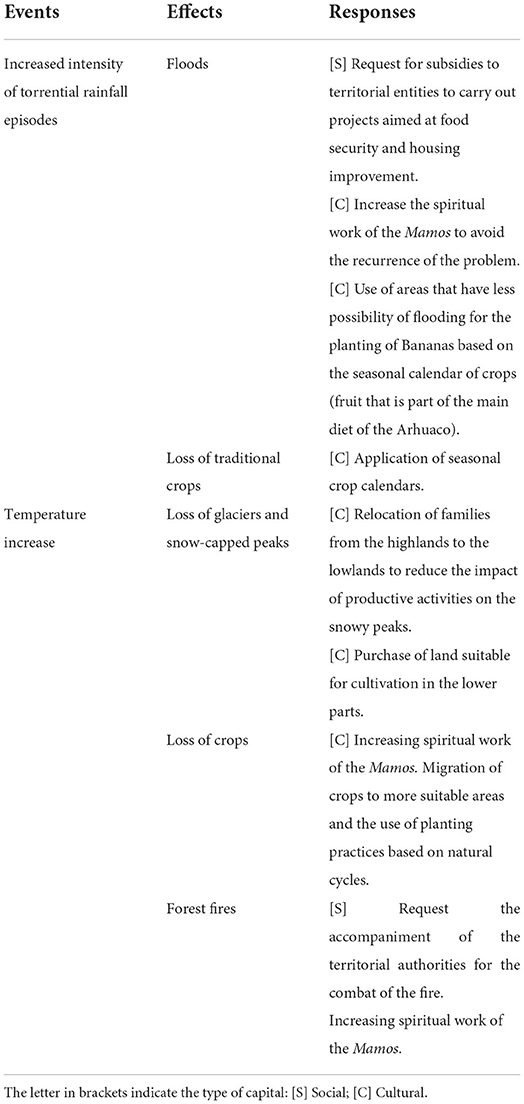Indigenous perceptions and adaptive responses to the impacts of climate variability in the Sierra Nevada de Santa Marta, Colombia
- 1Departamento de Desarrollo Rural y Regional, Facultad de Estudios Ambientales y Rurales, Pontificia Universidad Javeriana, Bogotá, Colombia
- 2Department of Geography, Indiana University, Bloomington, IN, United States
The exposure, risks, and impacts of climatic changes are most acute for marginalized and disenfranchised groups, particularly Indigenous Peoples. Worldwide, Indigenous Peoples are exposed to a wide range of climate threats that generate a broad spectrum of risks to their wellbeing. Responding to a request from the Arhuaco, this paper examines Arhuaco Indigenous perceptions of climatic variability, the impacts of this variability, and the response to such impacts. The empirical basis of the paper is the fieldwork on four Arhuaco settlements in the Sierra Nevada de Santa Marta, Colombia. We gathered data through surveys, semi-structured interviews, and focus groups. The results of our qualitative and quantitative analyses are: (1) Indigenous perception of climatic variability is consistent with meteorological data; (2) Loss of traditional crops is the most relevant impact; (3) Social and cultural capitals are the most used for adaptation strategies to climate variability; and (4) vulnerability results from non-climatic factors which shape the response capacity to environmental change. Insights from our work contribute to generate new knowledge about impacts of climate variability on Indigenous livelihoods, the responses to such impacts, and to understanding the linkages among climate, capitals, and adaptive responses from marginalized groups in Western society. Finally, our results provide valuable Indigenous practices and perspectives for improving policies to adapt to climate change and strengthen the resilience of local populations.
Introduction
One of the great challenges of the 21st century is responding to unprecedentedly swift, widespread, and intense anthropogenic climate change (IPCC, 2021). An important component of this challenge is the increasing frequency and magnitude of weather and climate extremes, including hot extremes, heavy precipitation, and droughts with some irreversible impacts (IPCC, 2021; Pörtner et al., 2022). Both climatic change and variability have caused negative impacts and related losses and damages, whereby “Across sectors and regions the most vulnerable people and systems are observed to be disproportionately affected” (Pörtner et al., 2022, p. 7). The impacts of the enlarging climatic variability will be even larger with additional warming (IPCC, 2021).
Though increased climate variability and extremes have already driven acute food insecurity and reduced water security for millions of people, the combination of loss of food production, limited access to food, and reduced diet diversity has increased malnutrition among Indigenous Peoples, small farmers, and poor households (Pörtner et al., 2022). Indeed, Central and South America is one of the regions wherein these groups will be most severely affected (Hagen et al., 2022).
Severe impacts on Indigenous Peoples are due to the growing threat of exacerbated climatic variability over community livelihoods (Schneider et al., 2021; Wagle et al., 2021; Bauer et al., 2022). Though another factor of the severity is the preexisting social vulnerability of Indigenous Peoples (Ford et al., 2020). This “starting point” vulnerability relates to the available resources and capitals, and individuals and groups' entitlements to access these resources, technology, and social support; access, in turn, is determined by the social and economic conditions of these communities (Kelly and Adger, 2000; Smit and Skinner, 2002) Furthermore, direct impacts of extremes of climate on livelihoods also contribute to vulnerability as resources become unavailable, enhancing the preexisting vulnerability and reducing the capacity to respond to disturbances (McDowell and Hess, 2012; Postigo, 2019) There are also environmental and institutional contexts at meso and macro levels that shape local vulnerability and cannot be addressed by the actors at this level (O'Brien et al., 2007; Ostrom, 2007; Takahashi et al., 2016; Findlater et al., 2018).
Despite pre-existing and long-standing non-climatic vulnerability, the history of Indigenous Peoples shows that they have maintained biodiversity and adapted to climatic variability and change (Brondizio et al., 2019; Reyes-García et al., 2022). Adaptive responses to changes in regular weather patterns rely on Indigenous Peoples' perceptions, knowledge, and capital (Nash et al., 2019; Wagle et al., 2021; Bauer et al., 2022). Perceptions identify both the relevant livelihoods impacted and the changes in climatic variability, which might inform early warning systems under current uncertainty (Gurgiser et al., 2016; Dang et al., 2019; Altea, 2020; Fierros-González López-Feldman, 2021).
The use of various capitals as a strategy by indigenous people to address climate variability has been utilized as the research approach by various anthropological and sociological researchers in recent years (Gallopín, 2006; Elsass and Peter, 2015; Cutter, 2016a,b; Dang et al., 2019; Karki et al., 2020; Kumar et al., 2020; López Feldman and González-Feldman, 2021; Pinho et al., 2022). Some analyses in India, Brazil, and Colombia show that the availability of cultural, social, and economic capital contributes both to forest and water source conservation practices in times of drought, and to building barriers and infiltration ditches to reduce the impact of flooding in periods of excess rainfall. In the same line, some studies indicate that the use of social capital favors the development of governance structures for decision-making for disaster prevention and improves the levels of cooperation between local actors and public institutions to address these emergencies, while economic capital promotes the expansion of traditional agricultural production systems which create less environmental externalities (López Feldman and González-Feldman, 2021).
Other studies and systematic reviews (Ulloa, 2011; de Matos Carlos et al., 2020; Karki et al., 2020) show that while livelihoods represent an integral component in reducing vulnerability and increasing adaptation strategies, the limited available information inhibits some studies from fully understanding the contributions of these capitals to setting adaptation strategies, the comprehension of communities' perceptions about these adaptation strategies and learning about the influence of issues such as armed conflict, socioeconomic marginalization or rural poverty on the use of the capitals to adapt to climate variability.
Similarly, ecological anthropology research results add to this discussion valuing daily life and community perceptions as input for producers to understand the behavior of the climate variation at local scales (Ulloa and Prieto-Rozo, 2016). In this sense, the valuation of traditional and ancestral knowledge becomes a fundamental tool that allows the material and immaterial subsistence of communities. It also benefits the design and application of public policy to deal with climate change and climate variability events.
Further, perceptions fine attuned to the local context provide insights for assessing risks, making decisions, and understanding the interplay of exo-local factors with adaptation strategies (Oliveira and Andrade, 2012; Córdoba et al., 2020). A critical component of adaptive strategies is the capitals available and accessible to local communities.
We understand capitals as different types of resources (e.g., natural, social, financial) that enable community responses to environmental and climatic constraining conditions (Flora and Flora, 2016). Examples of responses based upon capitals are technologies, stormwater storage, irrigation, agroecological practices, adjusted hunter and gather practices, and community rules for risk reduction (Sánchez et al., 2013; Abrams et al., 2019; Thompson and Lopez Barrera, 2019). But capitals are also the basis of community livelihoods, thus, variability might have a double impact on capitals as it compromises both the capacity to respond to challenging conditions and households' livelihoods. As shown in Figure 1, the increase in adverse weather impacts both the livelihoods of the community and the five capitals that enable both responses to climatic variability and impact reduction. We analyzed the double impact of climate variability on the capitals of Arhuaco Indigenous people of the Sierra Nevada de Santa Marta in Colombia. Specifically, we investigated how exacerbated climatic variability compromises Arhuacos' capitals capacity to both respond to climate extremes and produce food.
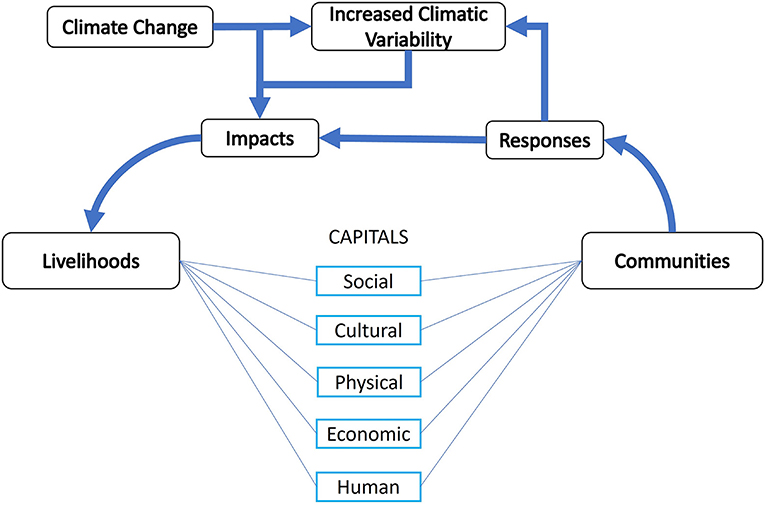
Figure 1. The explanatory framework of livelihoods and capitals in the context of climate variability. Dark blue arrows indicate that climate change increases climate variability, its impacts on community livelihoods, and response actions. To respond to the impacts the community uses the five capitals that are in the center of the figure connected with light blue lines.
Research on Indigenous Peoples in the Sierra Nevada de Santa Marta has been historically limited (Dolmatoff, 1982). Though scarce research is explained by Arhuaco being not particularly open to foreigners (Peter, 1992), more recently, armed conflict has been added to geographic isolation in hindering studies on the region. This conflict is a political phenomenon external to the community that limits the development of its capitals. This context underscores the relevance that our research was carried out at the request of the Arhuaco, who have been identifying changes in climate variables and their impacts while participating in government's mechanisms for adaptation and disaster management.
The Arhuaco invitation allows us to understand the linkages among climate variability, livelihoods, and social-cultural Indigenous systems.
The Sierra Nevada de Santa Marta was created as an Indigenous reserve in 1974 and as a protected area a decade later. Currently, over 50,000 Indigenous persons of the Arhuaco, Kogi, Wiwa, and Kankuama live in 52 settlements in the reserve. The Arhuaco are well known in the country for their activism defending and enforcing territorial rights (Lizarralde et al., 1987). The language in the study area is Arhuaco or Iku, though more than 23% of this population no longer speaks their native language because of the migration of young people due to the armed conflict. The reduced use of the native language constitutes a significant cultural loss. The Arhuaco families form exogamous patrilineal clans that used to control parts of the territory and had a ceremonial house (Lizarralde et al., 1987).
We conducted research in the Arhuaco settlements Atikwakumake, Simonorwa, Jerwa, and Dunawa located on the north and southeastern sides of the Arhuaco Indigenous reserve of the Sierra Nevada de Santa Marta (total area of 195,900 ha) in Colombia (see Figure 2). The elevation of settlements ranges from 1,000 to 2,100 meters above sea level. Each settlement is inhabited by approximately 40 families. The households in the settlements have a subsistence agricultural economy. The spatial pattern of land use consists of planting near the house fast-harvest products such as bananas, beans, corn, potatoes, vegetables, and keeping livestock. Households cultivate, farther from the house, cash crops such as coffee, cocoa, and avocado on small farms. Coffee is the predominant crop, using 76% of the study area (De La Hoz Montes et al., 2019). Cultivation of crops at different elevations diversifies production, allowing both better use of the different eco-climatic conditions, and risk reduction in the face of extreme events.
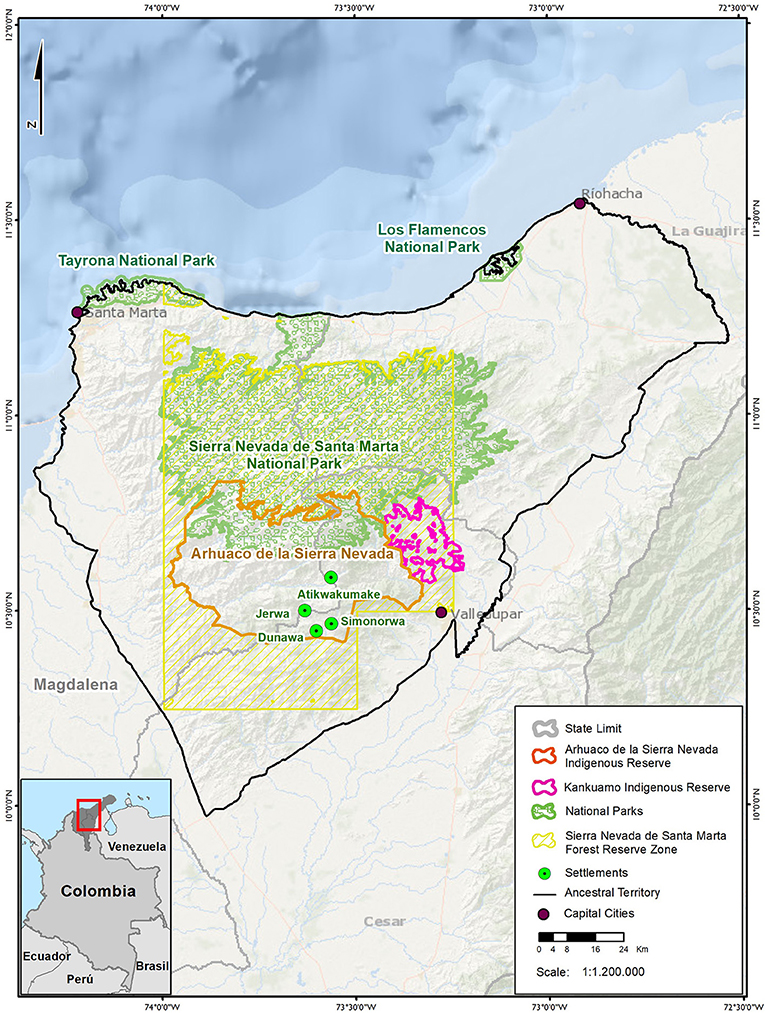
Figure 2. Study area. It shows the four Arhuaco settlements, the indigenous reserves, and protected areas.
The governance structure of the settlements is based upon the Mamo a traditional and religious authority who leads the settlement and determines the actions for the development of the households. Mamos, as priests, are the intermediary between supernatural powers of the religious realm and the Indigenous material world (Lizarralde et al., 1987). Mamos interpret, transmit, and enforce the Law of origin to guide and guarantee cultural continuity and autonomy over time. Other authorities in the settlement are the commissary, Cabo, and Semanero who are responsible of law enforcement, and finally all the families in the settlement.
The authority of the Indigenous reserve is the Tayrona Indigenous Confederation (CIT), which represents the Arhuaco People before the National Government. The creation of the CIT in 1978 changed the governance of the reserve. Formed by Mamos from each settlement in the reserve, the CIT establishes the norms for all the Indigenous Peoples in the reserve. Moreover, the CIT is recognized at the national level and is one of the four regional organizations in the permanent indigenous consultation meeting with the national government.
The leadership of the CIT ask for guidance at the four Kankurwas (sacred places). The structure of the CIT is the general assembly formed by all the Mamos and the Cabildo governor; the executive board; the Cabildo governor, an Arhuaco elected as a mayor by the indigenous and civil authorities, represents the CIT; zonal authorities as advisers; authorities from nearby regions; and all the Indigenous in the reserve. The form of multi-level Indigenous governance from the settlement to the whole territory allows that Indigenous people define their norms and procedures to access resources, regulate, and control the interventions of external institutions. For instance, in 1973, the Arhuaco promoted the creation of the Black Line surrounding an area of ~18,000 km2 encompassing sacred sites according to the Arhuaco, Kogui and Malayo. However, there are sacred sites beyond the reserve that the Indigenous have demanded to be protected.
Land governance in the reserve combines and overlaps multiple regimes. CIT determines that Indigenous families can occupy up to 20 ha, but the economic exploitation is limited to only 10% of this land. The CIT co-manages some areas of the reserve with the Colombian National Parks agency. As such, National Parks co-manages with CIT 40% of Sierra Nevada de Santa Marta National Park located on the north side of the reserve. Similarly, the Autonomous Corporation of Cesar co-manages with the Protective Forest Reserve 27% of area in the southeastern zone. Further, protection categories that cover 100% of the reserve are the Biosphere Reserve and the Cultural Heritage of Humanity.
Land governance has been further complicated since the 1950s because of the presence of armed groups in the reserve. These groups have promoted the expansion of illicit coca and marijuana crops, displacing Indigenous families inside and outside the reserve. The constant threat to the Arhuacos' lives has weakened their culture; for instance, constraining the use of Indigenous justice. These illegal activities have forbidden some practices, limiting the regular Arhuaco way of life. The pressures on the landscape and governance increased with land-use change through agriculture and extensive ranching. These land uses resulted from two types of appropriation of the territory. The first was conducted by peasants and settlers who migrated from the interior of the country as they escaped from the armed conflict. The second appropriation was done by immigrants who came attracted by the marijuana and coffee boom. Illegal crops and land dispossession by new land uses have led to deforestation, invasion of sacred places, overgrazing, and soil degradation.
The study area has a steep mountainous part and a flat part. Precipitation has a bimodal rainy season with precipitation from April to May and from September to November; the first season is more intense. The dry seasons occur from December to March and from June to August. The average annual relative humidity is 75% in the mountainous area and 60% in the flat area.
This diversity of ecosystems and microclimates in the higher and lower parts of the settlements determines different farming systems. The soils of the reserve are characterized by low fertility, high content of aluminum, and the presence of rocks and superficial gravel, which limit farming productivity. However, agriculture in the reserve is particularly salient in the lower parts which have soils of higher fertility. Forestry is suitable for the reserve's topography characterized by steep and abrupt slopes. Further, land cover change had been driven by the population displaced by the armed illegal groups in the last century (De La Hoz Montes et al., 2019).
Methods
We collected quantitative and qualitative data from the settlements Atikwakumake, Dunawa Jerwa and Simonorwa to understand the local perceptions of climatic variability and the impacts of this variability on Indigenous livelihoods. We conducted 15 semi-structured interviews with community leaders, five focus groups with 18 adult people (10 men and eight women). Each focus group address different topics: Livelihoods; perceptions on climate change; adaptation strategies; impacts of climate change; and recommendations to improve adaptation. We conducted 94 surveys in households selected based upon access, security, permissions granted, safety of enumerators and household members, and altitudinal differences to capture a greater level of heterogeneity in perceptions and livelihoods. The specific households to be surveyed, however, were defined in agreement with the Indigenous authorities. Though this strategy for data collection might not be based on a representative sample, we respected the decision and selection conducted by Indigenous authorities and valued having the privilege of accessing these populations under pandemic conditions. These limitations notwithstanding, participants were 48.5% women and 51.5% men. Participation by gender at the settlement level varied with higher participation of women in Atikwakumake and Simonorwa and most men in Jerwa and Dunawa. The majority of respondents (94.5%) were older than 50 years old and 5.75% were younger than 30 years old.
Secondary data were obtained from the local offices of planning and development, the Institute of Hydrology, Meteorology and Environmental Studies (IDEAM), the Regional Autonomous Corporations, and National Parks. Meteorological data of daily precipitation and monthly temperature for the last 29 years in the study area were obtained from the station of Pueblo Bello. These data were analyzed using R software version 4.1.1. to show monthly and annual trajectories of precipitation and temperature, and changes in the onset of the rainy season (i.e., May) and the range of variability for May were illustrated using boxplots.
Data on people's perception of both climate variability and its impacts on capitals was assessed using the survey, the focus groups, and the interviews to key informants. The survey asked for impacts on livelihoods with indicators per each capital however, responses not covered by the indicators were registered by the enumerators and then included in qualitative data collection (i.e., focus group and interviews).
Qualitative data on livelihoods and capitals were collected in a two-step process. The first step was the identification of the main impacts of climate variability on livelihoods during the focus groups. The level of impact on the six capitals (social, cultural, economic, physical, natural, human) was determined by the Indigenous using a score from 0 to 3 (0 the lowest and 3 the highest influence). A radial graph was made with this qualitative score.
The second step was the creation of an index of the capitals' condition per settlement using the survey data. The index allowed comparing livelihoods of each capital among settlements. Table 1 explains the variables used to link livelihoods with each capital type. Radial graphs of the capitals' condition were made using the indices, the variables were normalized to a range of 0–1 using the Min-Max statistical function. In the resulting 0 to 1 range, 0 indicated the worst condition of a capital and the closest to 1 the best. Though we use capitals to assess the availability of assets to deal with climatic variability, these categories do not directly reflect Arhuaco worldviews.
Results
Climatic variability: Trends of precipitation and temperature
Figure 3 shows monthly average precipitation and temperature from 1990 to 2019. The rainiest months are May and November with an average precipitation of 320 and 300 mm. respectively, in the 29 years analyzed. The driest months are January and February, including 0 mm of precipitation in the first part of the year. The hottest months are December, January, and July with temperatures around 25°C. The months with the lowest temperature are May and November with temperatures around 19°C. On the east side, however, temperature presents a different pattern with an average of 23.2°C, which is, 1.3°C lower than in the west.
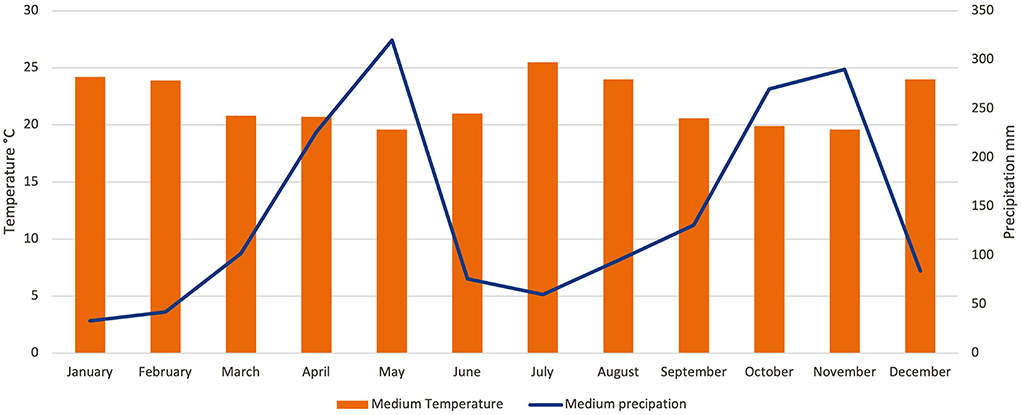
Figure 3. Average monthly precipitation and average temperature from 1990 to 2019 in the study area. The orange bars express the average monthly temperature and the blue line the average precipitation for 29 years.
The 29-year analysis shows wide inter-annual variability in precipitation, reaching up to 75% difference in the annual precipitation between 2010 and 2015. As seen in Figure 4, the rainiest years were 2009 and 2010 with total precipitation of 4,482 and 4,400 mm, respectively. The least rainy years were 2004 and 2015 with 2,688 and 2,522 mm of precipitation, respectively. Temperature variability was also observed. We identified a difference of up to 2.5°C between the hottest years (2002 and 2015) and the coldest ones (2000 and 2003).
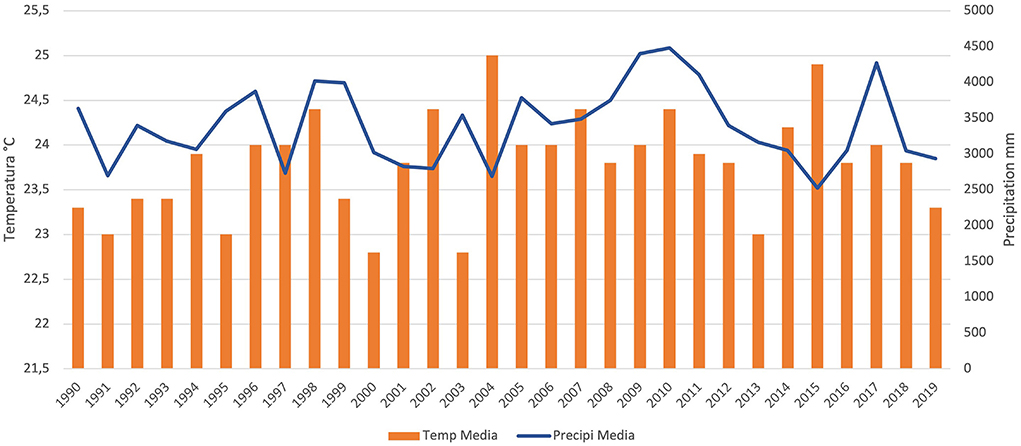
Figure 4. Average annual precipitation and average temperature since 1990 in the study area. The orange bars show the average annual temperature and the blue line the average monthly precipitation.
Analyzing the data since 1990, we identified four ways of climate variability, particularly striking in May. First, average precipitation varies especially in May, and temperature in July. As shown in Figure 5 precipitation varies from 6 mm to 16 mm for some years while temperature variation ranges from 22.5 to 25°C.
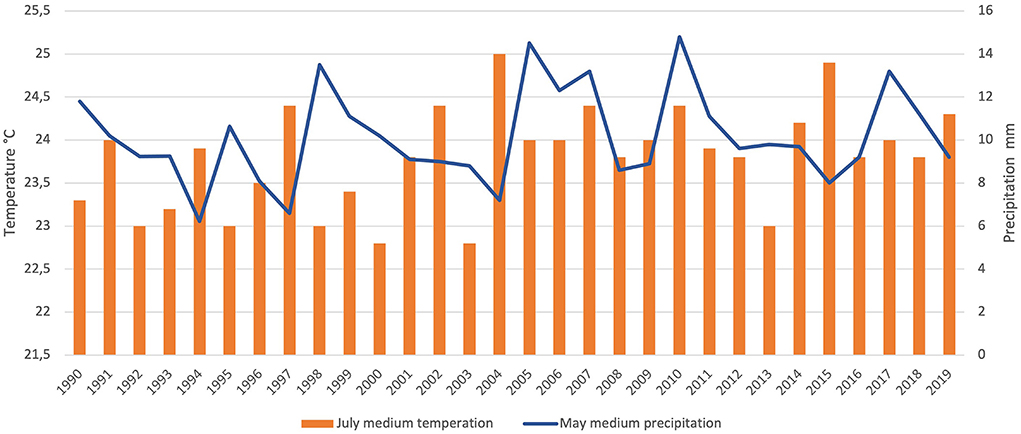
Figure 5. Average monthly precipitation and temperature for May and July since 1990 in the study area. The orange bars show the average monthly temperature for the month of July and the blue line the average monthly precipitation for May during the last 29 years.
Second, the beginning of the May rainy cycle has been occurring earlier by at least 8 days since 1990. Figure 6 shows the change of the beginning of the rainy season from 1990 to 2019. During the 1990–2001 decade the onset of the rainy season was either May 1 or 2nd whereas from 2002 to 2019 the rainy season began either in April 26 or 24th. The dramatic advancement of the onset of the rainy season by 6–8 days has led farmers to modify the traditional planting dates.
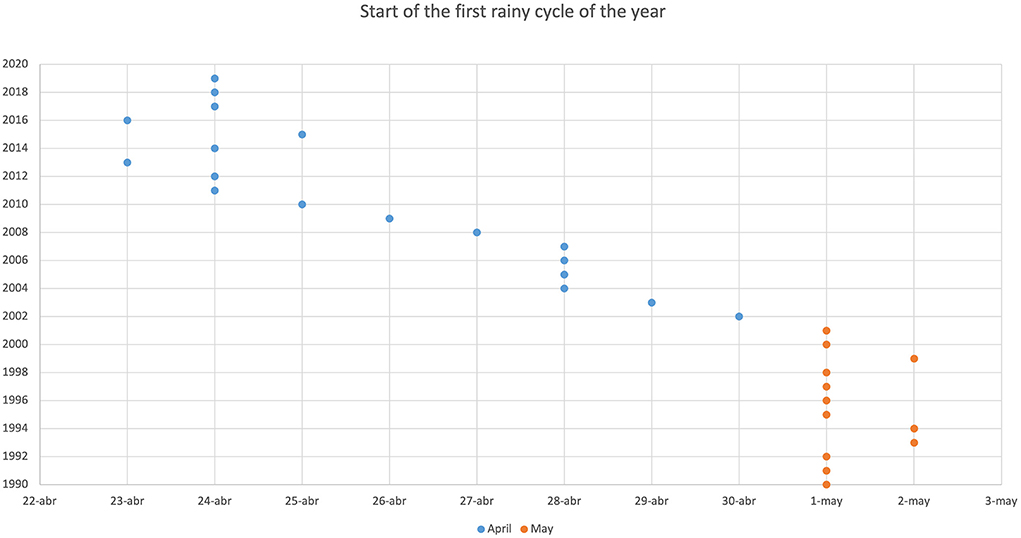
Figure 6. Changes in the start day of the May rain cycle since 1990 in the study area. The orange dots indicate the start day of the first rain cycle of the year from 1990 to 2000, the blue dots show the beginning of the rainy season from 2002 to 2020. Precipitation onset has anticipated for 8 days since 2004.
Third, there has been large variability in the number of days (column duration) and total precipitation in the May rainy cycle of the 29 years analyzed (Table 2). Consequently, we also found large variation in the average daily precipitation of this season when we divided the total precipitation by the number of days (Column average in Table 2). In this sense, the duration of the annual cycle's year changes as well as the amount of precipitation, 1990 and 2001 being the years where the greatest intensity is observed.
Finally, the daily precipitation in May has also changed. The box plots in Figure 7 present the daily precipitation in May ranging from 0 to 23 mm. The rainiest months of May were in the years 1990, 2000, and 2013. The maximum daily precipitation reached up to 90 mm. The month of May 2015 is considered unusual because the rains lasted only 5 days and advanced to the month of June.

Figure 7. Range distribution of daily precipitation in May during the last 20 years. The bars express the median and points outside the bars show outliers for the month.
Community perceptions of climatic variability and its impacts
The widest perceptions among Arhuaco communities were modifications in the weather regarding irregular distribution of rainfall in the rainy season and unexpected high temperatures. The results of the surveys indicate that 98% of the adults perceived an increasing intensity of rainfall during May, and higher temperature throughout the year, although the latter was particularly severe during July.
Perceptions were also specified in terms of climate variables (precipitation and temperature) in different years. 95% of the respondents perceived that precipitation changed most in 2010 and 2011. Similarly, 86% perceived that the greatest temperature change occurred in 2015.
It is generally perceived that changes in climatic variability are multicausal. A group of causes was mainly associated with divine punishments because of the reduction of religious offerings and the deterioration of the forests. Sacred places have also been reduced and enclosed by the expanding agrarian frontier through palm plantations, livestock, and small farming on the southeast side of the reserve. Quantitative results show that around 75% of respondents attributed the variability to natural phenomena, 10% to the gods, and 15% to human activities. 4% claimed international policy as the changing cause since it harms the most vulnerable populations and favors large industries.
Perception of the causes of climate variability might also indicate possible pathways to response strategies. About 95% of respondents mentioned the convenience of relying on god's protection and the government institutions for addressing the impacts of climatic changes. The divine protection requires better religious offerings. The government is expected to control the expansion of the agrarian frontier and the associated deforestation. One strategy for controlling the expansion of the agrarian frontier mentioned by 96% of the respondents is the creation of “Talanquera Peoples.” These are settlements in the reserve promoted in the last 10 years by the CIT to prevent the colonization of lands. Additionally, CIT has strategies to move families settled for more than 10 years to non-intervened areas, thereby reducing the impacts of prolonged occupation on ecosystems, and guaranteeing passive restoration in areas unused for more than 20 years.
People also expressed their perceptions of the impacts of climate variability. The perceived impacts were melting of glaciers, increased flooding, and yield reduction of traditional crops such as corn and beans in the highlands (2,500–2,700 masl), and coffee and bananas in the lowlands (1,000–1,500 masl). The main concern about glaciers melting is reduction because they are considered sacred places. This concern shows again the salience of divine elements in the relations between the Arhuaco and their climate.
Climatic shifts also impact nontraditional crops. Most of the respondents (76%) perceived decreasing coffee production and attributed it to water stress during the summer (July), and pests such as the mealy louse (Planococcus ficus) and leafminer (Leucoptera coffeella). It is perceived that the incidence of pests has intensified in the warmest months, particularly in the settlements El Playón, Paragaca, La Caja, Motrua, Mamagaca, and San Quintín in the Cesar Department, and the region of Chinchincua in the Magdalena Department. Nontraditional crops are also affected by forest fires generated by small farmers and settlers in the lowlands of the reserve, and closeness to populated centers such as Pueblo Bello, Dunawa, and Simonorwa.
The main impact associated with increased precipitation is flooding in the plains of the Dunawa and Simonorwa settlements during May and November. Rainfall in these months reaches up to 320 mm per month. Further, respondents mentioned that in the last 10 years, rainfall intensity from middle April to the beginning of May has flooded fields of beans and corn in the highlands. The indigenous in these settlements perceived that the floods with greatest impacts happen in 1990 and 2001; years with the more intense annual rain cycles (see Table 2).
Impacts of climatic variability on capitals
Figure 8 presents the impacts of climatic variability on Indigenous capitals; social, cultural, natural, physical, and economic capitals are the most affected. Social capital is affected as the majority of household heads (90%) reduced their participation in collective decision-making during drought periods because they need time to irrigate and take care of the livestock. Another impact of drought on social capital is the weakening of confidence and trust among families, which leads to growing tensions over water access and forest loss.
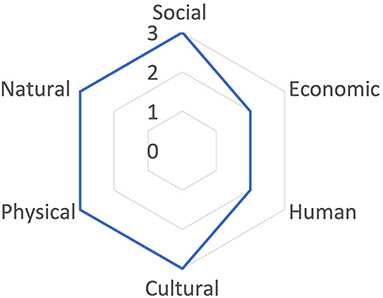
Figure 8. Impacts of climate variability on capitals according to households' perception. Impacts range from 0 to 3 (0 is the lowest and 3 the highest).
Cultural capital is impacted by the loss of knowledge and sacred places. Three additional aspects introduce risks to the cultural capital. First, stopping wool production threatens women's traditional knowledge of backpack making. Second, intensified forest fires led to a loss of forests, biodiversity, and sacred places. The latter are essential for offerings and health-related rituals. Third, losing medicinal plants and traditional knowledge. Biodiversity and forest loss reduce the natural capital, similarly in the reduction of water sources and snow-capped peaks which provide water and are considered mighty beings.
Non-climatic processes also threaten Arhuaco's natural capital. Expanding deforestation, monocultures, and livestock use by peasants in areas surrounding the reserve are threats to the natural capital. For instance, 99% of respondents think that forest fires in July to expand pastures, are particularly harmful to forests and sacred places in the reserve. Similarly, peasants' intensive planting without rotation in the lowlands has led to soil erosion and landslides during the May rains.
The most conspicuous impact of intensified rainfall on physical capital, noted by 88% of the respondents, is the deterioration of tertiary roads, which are fundamental to access both markets for agricultural production and schools for children and young adults from the settlements.
Related to the impacts on the economic capital, 93% of the households consider that the amount sold and self-consumed of corn, beans, coffee, and bananas has decreased because of a higher incidence of pests and diseases. According to 75% of respondents, pest control has increased production costs, discouraged farming while incentivized youth outmigration for jobs in nearby towns. In the high parts of the reserve, around 65% of respondents noticed the decline in food production due to outmigration to the lowlands, wherein they can cultivate more crops tolerant to water stress. Most women (89%) remembered the death of goats due to dehydration in 2015, which led the households to abandon wool production for manufacturing backpacks, a traditional women's activity and one of the main sources of household income.
It is important to highlight that 83% of families consider that the loss of cultural capital translated into traditional knowledge for soil management, food production and land use planning is indirectly driven by the loss of economic and human capital. Figure 8 shows that the impact of climate variability on economic and human capital is less than cultural and social capitals.
The impact of climate variability is stronger in contexts with social marginality. For instance, armed groups prevent access to areas with fertile soils because these are used for illicit crops; settlers and peasants invade the land, limiting the area for families who must resettle and leave for passive recovery the land they have been farming for over 10 years.
Adaptation strategies and uses of capital to face climate variability
Adaptation strategies are based on the use of capitals. 98% of respondents indicated that social and cultural capitals are the most important and used to face climatic emergencies. Social capital refers, for instance, to creating spaces for decision-making and forging institutional alliances to deal with emergencies. Cultural capital underpins, for example, traditional spiritual cleansing practices and ancestral knowledge for the management of natural cycles.
Most respondents (95%) think that the use of the capitals identified in our study provided solutions within the reserve. However, it was considered particularly problematic when social and cultural capitals were low and planned actions were limited. For instance, low cultural and social capitals of Dunawa manifested on reduced ecological knowledge and spaces for both cultural reflection and decision-making about weather risks. Further, settlement capitals are also challenged by government non-recognition of collective lands and the immigration of settlers.
Table 3 summarizes the climatic variability-related events, their effects, and the responses implemented by the settlements. Four recurrent practices can be identified: first, the use of cultural capital associated with the spiritual work of the Mamos consisting of cleansing and offering for the gods to mitigate the causes of the climatic event. Second, cultural capital underlies farming practices based on seasonal calendars of traditional crops. Third, the use of social capital for relocating families and purchasing agricultural land. Fourth, the search for external aid to cope with floods and droughts-related emergencies, particularly since 2010.
These strategies are generally designed and implemented by individuals with different levels of authority in the settlement. The Mamo guides the work to reduce risks, selects, and adapts spaces for spiritual cleansing. However, Indigenous households autonomously decide the planting dates and places, following the seasonal crop calendar. The Cabildo Mayor or the highest position of the town's government, occasionally with the Mamos, decides land purchases and requests the involvement of other government agencies.
The availability of capitals enables or limits adaptation strategies in the settlements. Consequently, strategies for responding to the impacts of climate variability are similar in the four settlements, though the prevalence of certain responses depends on the specific capitals available. In general, though, adaptive practices were reactive. Unplanned responses limited opportunities for dialogue that would have allowed, for instance, a collective agenda for addressing the high-risk winter emergencies.
Figure 9 shows the differences and similarities in the availability of capital among settlements. The main similarity is that the families in the four settlements have insufficient economic capital (low income, limited marketing channels and product sales), limited access to credit, and low possibility of saving) and little human capital (limited availability of labor and hiring possibilities).
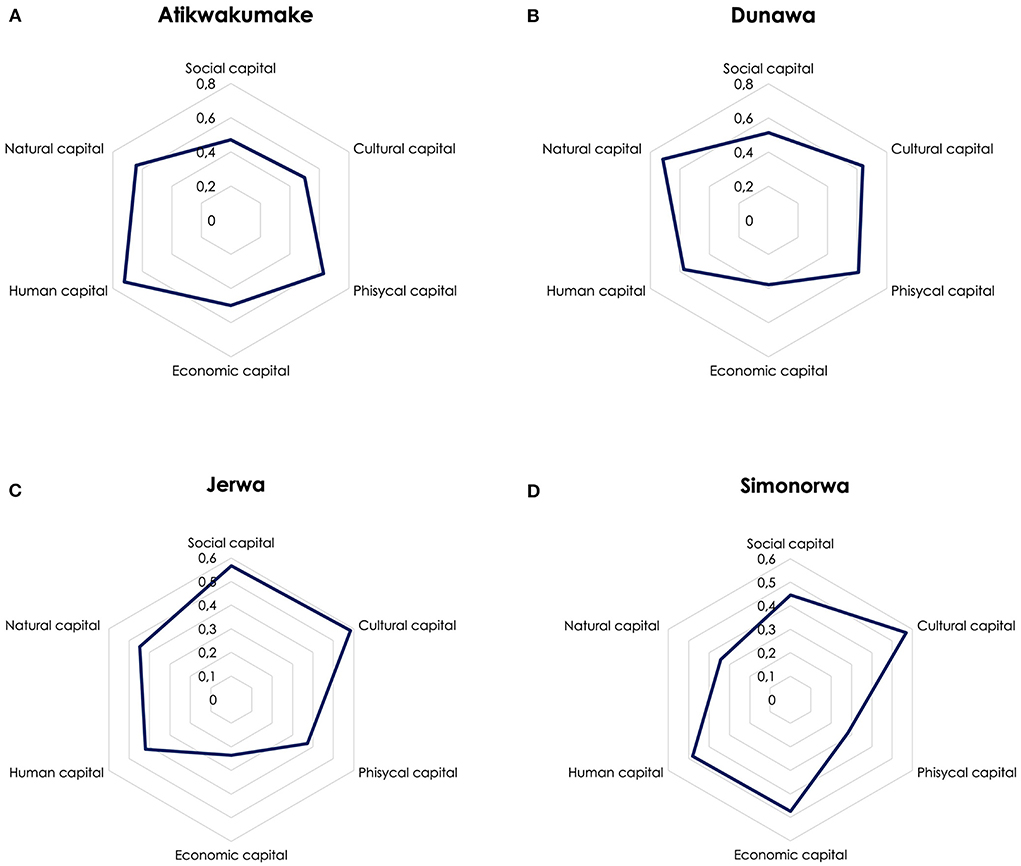
Figure 9. Capitals available per settlement [(A) Atikwakumake, (B) Dunawa, (C) Jerwa, (D) Simonorwa]. The state and diversity of the capitals used in each settlement to face climate variability was built through the normalized range 0–1, 0 being lowest and 1, highest.
The differences on available capitals among settlements are observed in two aspects: first, only Jerwa and Simonorwa have cultural capital, two of the areas furthest from the populated centers. Second, the availability of social capital is greater in Jerwa than in Atiwakumake, despite the fact that the latter settlement is the area closest to the capital of the indigenous reserve (Nabusimake) where political-administrative decisions are made. This last result is important because it seems that the promotion of social development and conservation projects in Jerwa has strengthened indigenous collective work and has fostered the use of traditional knowledge threatened economic precariousness.
In Jerwa and Simonorwa culture is the most used capital to address the impacts of floods and droughts. It is associated with greater capacity to use cultivation calendars and cleansing spaces by the Mamos to mitigate the impacts of floods and droughts. Crop calendars are important because they allow households to define the productive and nutritious crops to be planted, the planting location, and the time. Calendars also ease planting decisions based on changes in the rainy season. For instance, intensified May rainy season has led to earlier sowing by approximately one month. In doing so, crops avoid diseases emergent with heavy rainfall. Specifically, the former sowing that used to start in April and waited for the rains of May has shifted to March.
Other farming responses involved replacing traditional crops such as maize (Zea mays) with more resistant crops such as cocoa (Theobroma bicolor), Tahiti lemon (Citrus latifolia), and malanga (Colocasia esculenta). This change led to a spatial reconfiguration of crops and their commercialization. The reduction of traditional crops in the highlands has led to a concentration of food production for markets and not for self-consumption in the lowlands of the reserve. Another modified farming practice is the change of planting times of fruit trees in response to rising temperature; for example, lemon and cocoa that used to be planted in July are now planted in September and even November.
In Simonorwa, Dunawa, and Atikwakumake the availability of economic capital improved the reserve's decision-making process on land purchases. Some households even mentioned improving their economic capital as they access more land donated by the government or bought by CIT. Though climatic variability hinders herding goats, Indigenous people buy wool to continue manufacturing mochilas, which, as one of the main sources of income for the settlements allows income diversification and increased purchasing power for food. The diversification and increased purchasing power also reduce the dependence on traditional crops that are less profitable and productive.
In the settlement Jerwa, social capital enabled households (and showed leaders of other settlements) to participate in collective decision-making for requesting emergency aid to cope with forest fires and floods in 2010. This experience strengthened social capital by promoting community alliances with government agencies such as National Parks and the Regional Autonomous Corporations for addressing crop losses. Further, the interactions with these agencies served to define mechanisms of emergency response and access to economic aid. Further, these experiences have promoted community participation in the design of adaptation policies at the country-level; this involvement had been demanded by the Arhuaco since 2018.
While capitals are the foundation of adaptive responses to the impacts of climatic variability, we also found evidence of the reverse, whereby limited capitals hinder adaptive strategies. The community Dunawa underscores how scarce social and cultural capitals disabled adaptive strategies. Specifically, Indigenous in Dunawa recognized that the loss of traditional knowledge hampered the yield of traditional crops particularly affected by rain. Moreover, the loss of social capital impedes participation in collective decision-making for planning the purchase of productive land to make up for areas reduced by floods.
Discussion
Perceived and detected climatic variability
The meteorological data are consistent with people's perceptions about changing patterns of climate variability. Data and local observations identified changes in the precipitation regime. Indigenous Peoples have been experiencing the earlier onset of the rainy season which has also been registered by meteorological data. The consistency between these two knowledge systems might be a building block for co-producing knowledge about climatic variability, yielding information with different spatial and temporal resolutions.
The Arhuaco request, authorization, and participation on this study reveals that they are interested and open to knowledge generated by Western science. We found that Indigenous interest for knowledge coproduction is an important element of the Arhuaco strategies to deal with climate variability. In the settlement Jerwa there is an institutional articulation that seeks to work together in the design of culturally viable adaptation strategies. Though these kinds of articulations are important for sustainable transformations (Schneider et al., 2021; Reyes-García et al., 2022), knowledge co-production requires monitoring power relations among knowledge systems and understanding the social and political position from which knowledge is formulated (Haraway, 2009).
In the context of Colombia, our finding that Indigenous perceptions coincide with meteorological data supports the potential complementarity of Western scientific knowledge and other forms of knowledge for understanding environmental change (Córdoba et al., 2020). This potential facilitates the processes of dialogue and cooperation among the community and other stakeholders, including government agencies, on issues of climate change such as assessments of risk and vulnerability, and design of policies for adaptation and conservation (Ulloa, 2011). Furthermore, complementary knowledge and supportive policies will be crucial as long-standing adaptations might become vulnerable or insufficient to new extreme variability and sudden and unexpected changes (Janssen et al., 2007).
Our insights directly contribute to Colombia's recent recognition of adaptive practices of Indigenous and local peoples in policies like the 2018 national climate change initiative (Gobierno de Colombia., 2018). These policies promote research in identifying local strategies for adapting to impacts of climate change, reducing risks, and responding to disasters. These efforts are in line with the more recent Long-Term Climate Resilience Strategy of Colombia (E2050), which defined steps to achieve climate resilience and investment priorities (public and private) for a pro-vulnerable economic transformation.
Impacts of climate variability and the use of capitals for adaptation
The most important impacts of climatic variability on Arhuaco households were the loss of crops in May and July. We found that changes in precipitation and temperature might relate to these impacts on farming. Exacerbated climatic variability has created a sense of uncertainty around farming in Colombia, whereby shifts challenge the usual season indicators and increase pests and diseases (Lambert and Eise, 2020). However, our respondents also associated the losses with the reduction of snow-capped peaks and the loss of sacred places, evidencing the connection between climate and culture in Indigenous contexts. Understanding the cultural dimensions of climate change is crucial because cultural systems support both perceptions and adaptation, for instance, the importance of Mamos as traditional authorities that lead ceremonies to respond the impacts on livelihoods. Further, culturally insensitive exogenous adaptations will most likely be rejected, abandoned, or become maladaptation's.
We found that cultural and social capitals were the most frequently used in response to the impacts of climate variability on traditional crops. These responses, though, were short-term and, in some cases, might have even been mechanisms to cope with farming losses. The identified prevalence of this type of response among Arhuaco settlements indicates how little leverage Indigenous have to transform the economic and social drivers of their vulnerability, which, ultimately hinder achieving resilience (Córdoba et al., 2020). However, we also found that the use of social capital in some adaptation strategies included alliances with outside actors like aid agencies, indicating an openness toward external actors and resources for adaptation practices (Lambert and Eise, 2020).
Arhuacos' practices to address variations in precipitation and temperature rely on households' knowledge, which may contribute to the knowledge of scientists and other stakeholders in the processes of knowledge co-production. In doing so, elements of the capital used by Arhuaco households to address the impacts of climate variability have the potential to become part of this new type of knowledge supporting sustainable transformation (Norström et al., 2020; Schneider et al., 2021).
The perceptions and adaptation strategies that we found were determined by factors linked to the settlements' capitals (social, natural, and cultural), the households' livelihoods, and the territories' environmental and socioeconomic conditions. Though adaptation strategies are considered deliberate and rational acts, they are part of the households' possibilities at a given moment in a specific context (Ulloa, 2011; Lambert and Eise, 2020). Understanding the adaptation of vulnerable communities such as Indigenous people implies recognizing the individual and collective perceptions, and the external factors that influence such perceptions and adaptations (Jacobi et al., 2015; Asfaw et al., 2016; Meldrum et al., 2018; Dang et al., 2019; de Matos Carlos et al., 2020; Lambert and Eise, 2020; Wagle et al., 2021).
In the case of Arhuacos' territory, we found that the external factors such as violence, marginality, and insecurity greatly shaped both the adaptive strategies and the household vulnerability and limited the capacity to improve strategies and create new responses (De Los Ríos Cardona and Almeida, 2010; Bonatti, 2011). For instance, Dunawa settlement exposure to territorial conflicts and tensions between legal and illegal land uses, hinders developing appropriate adaptive strategies. These findings highlight the important interconnections of non-climatic factors with communities' exposure to climate change and their capacity to respond to it (Ford et al., 2020; Postigo, 2021; Wagle et al., 2021).
Conclusion
Arhuaco Indigenous peoples perceive climate variability chiefly in the increased intensity of both precipitation in the rainy season and temperature in the dry months. These perceptions are consistent with the analysis of 29 years of meteorological data. The consistency between indigenous and scientific detections of climatic issues, strongly supports the potential of complementing ways of understanding and assessing environmental change. Further, it encourages the inclusion Indigenous in policy making. In the case of Colombia, the consistent detection ensures the participation of Indigenous Peoples in the formulation of policies for improving adaptation and strengthening resilience.
The dependency of the Arhuaco's subsistence on farming renders crop losses the most relevant effect of climatic variability. Impacts like flooding directly caused the loss of beans and corn. However, new nontraditional cropping systems were put in place, and have increased farming income. Further, it is likely that increased temperature indirectly caused the loss of non-traditional crops such as coffee by driving pests to new areas.
Capitals are crucial in the interactions between households and climate variability. Capitals in the settlement are the foundation of household adaptation. Thus, the impacts of climatic variability on the capitals particularly challenge the capacity to respond to change and cope with its impacts. Capitals are heterogeneously distributed among the settlements, which is reflected on the different adaptive strategies implemented. But non-climatic factors operating beyond the settlements shape the capacity to respond. For instance, Dunawa is the most exposed to armed conflict, illicit land uses, and the informal occupation of traditional lands by white settlers. Consequently, Dunawa's limited adaptive strategies because of scarce capitals are further compromised by non-climatic factors that created social vulnerability. Addressing the drivers of social vulnerability will improve the living conditions of Indigenous Peoples and, consequently, their adaptive capacity to address climatic changes.
The study contributes to research undertaken on the local scale to understand communities' perceptions of climatic phenomena, and the cultural, political, and social dimensions of response strategies and vulnerability to climatic changes (Soares and Roberto, 2008; Andrade and Miccolis, 2012; Wiid and Ziervogel, 2012; Lambert and Eise, 2020; Wagle et al., 2021). Further, our study has generated information for the Arhuaco to use in governmental decision-making. Furthermore, understanding the impacts of climate variability on Indigenous livelihoods is crucial for adaptation strategies because it enables focusing limited resources and improves chances of implementing locally accepted strategies.
Our research responded to a request from the Arhuaco Indigenous Peoples. Our findings contribute to the growing inclusion of Indigenous strategies in policies for adaptation to climate change. In Colombia, particularly, the knowledge generated by this study supports the Arhuaco working with government agencies in designing policies about climate change. The relevance of these findings is particularly important when we consider the little research on the Arhuaco to date, and the increasing challenges of their way of life because of long-standing social and political marginalization and disenfranchisement. The results of this research also constitute knowledge for the Arhuaco than can inform their decision making. Knowing the leadership of the Arhuaco in the Indigenous movement, we hope that the valuable lessons generated through this research are shared with other Indigenous Peoples.
Data availability statement
The raw data supporting the conclusions of this article will be made available by the authors, without undue reservation.
Ethics statement
Written informed consent was obtained from the individual(s) for the publication of any potentially identifiable images or data included in this article.
Author contributions
V-EG-S conducted research with the community and collected information for analysis. JP analyzed the primary and secondary information for the construction of the discussion and conclusions. V-EG-S and JP wrote the article. All authors contributed to the article and approved the submitted version.
Acknowledgments
The authors are grateful to the Arhuaco Indigenous Peoples of the Sierra Nevada de Santa Marta for sharing their knowledge for this research and the Pontificia Universidad Javeriana for their financial support to publish this paper as Open Access.
Conflict of interest
The authors declare that the research was conducted in the absence of any commercial or financial relationships that could be construed as a potential conflict of interest.
Publisher's note
All claims expressed in this article are solely those of the authors and do not necessarily represent those of their affiliated organizations, or those of the publisher, the editors and the reviewers. Any product that may be evaluated in this article, or claim that may be made by its manufacturer, is not guaranteed or endorsed by the publisher.
References
Abrams, J., Erin, C., Pischke, M., Mesa-Jurado, A., Amarella, E., Chelsea, A., et al. (2019). Between environmental change and neoliberalism: the effects of oil palm production on livelihood resilience. Soc. Nat. Resour. 32, 548–65. doi: 10.1080/08941920.2018.1544678
Altea, L. (2020). Perceptions of climate change and its impacts: a comparison between farmers and institutions in the amazonas region of Peru. Clim. Dev. 12, 134–146. doi: 10.1080/17565529.2019.1605285
Andrade, R. M., and Miccolis, A. (2012). Diagnóstico de Percepção de Risco Ambiental e Mudança Climática No Núcleo Rural Da Microbacia Do Córrego Do Urubu. VI Encontro Nacional Da Anppas. 16. doi: 10.30878/ces.v25n1a1
Asfaw, S., McCarthy, N., Leslie, L., Aslihan, A., and Andrea, C. (2016). What determines farmers' adaptive capacity? empirical evidence from Malawi. Food Sec. 8, 643–64. doi: 10.1007/s12571-016-0571-0
Bauer, T., Wil De, J., and Verina, I. (2022). Perception matters: an indigenous perspective on climate change and its effects on forest-based livelihoods in the Amazon. Ecol. Soc. 27. doi: 10.5751/ES-12837-270117
Bonatti, M. (2011). Cambios climáticos, percepciones humanas y desarrollo rural, Universidade Federal de Santa Catarina, Tesis de maestria Desarrollo Rural. Colombia. doi: 10.13140/RG.2.2.25966.00323
Brondizio, E. S., Settele, S., Díaz, H., and Ngo, T. (2019). IPBES 2019 Global Assessment Report on Biodiversity and Ecosystem Services of the Intergovernmental Science-Policy Platform on Biodiversity and Ecosystem Services. Bonn, Germany: IPBES secretariat.
Córdoba, V., Cindy, A., Sonia Hortúa, R., and León-Sicard, T. (2020). Resilience to climate variability: the role of perceptions and traditional knowledge in the Colombian Andes. Agroecol. Sustain. Food Syst. 44, 419–45. doi: 10.1080/21683565.2019.1649782
Cutter, S. L. (2016a). Resilience to what? Resilience for whom? Geogr. Compass 182 (2):110–13. doi: 10.1111/geoj.12174
Cutter, S. L. (2016b). The landscape of disaster resilience indicators in the USA. Nat. Hazards 80, 741–58. doi: 10.1007/s11069-015-1993-2
Dang, H., Elton, L., Ian, N., and Johan, B. (2019). Factors influencing the adaptation of farmers in response to climate change: a review. Clim. Dev. 11, 765–774. doi: 10.1080/17565529.2018.1562866
De La Hoz Montes, M., Mirleydis, D., Perafán-Ledezma, A., and Martínez-Dueñas, W. A. (2019). Apropiaciones Sociales de La Ciencia y La Tecnología En La Caficultura En La Sierra Nevada de Santa Marta. Jangwa Pana: Palmor y Río Piedras, Magdalena, Colombia. doi: 10.21676/16574923.2925
De Los Ríos Cardona, J., and Almeida, J. (2010). Percepciones y Formas de Adaptación a Riesgos Socioambientales El Páramo de Sonsón, Antioquia, Colombia. Cuadernos de Desarrollo Rural. 7, 109–127.
de Matos Carlos, C., Sabrina de, da Cunha, D. A., Viana, P., and do Couto-Santos, F. (2020). Understanding farmers' perceptions and adaptation to climate change: the case of Rio Das Contas Basin, Brazil. Geo J. 85, 805–21. doi: 10.1007/s10708-019-09993-1
Dolmatoff, R. G. (1982). Cultural change and environmental awareness: a case study of the Sierra Nevada de Santa Marta, Colombia. Mountain Res. Develop. 2, 289–298. doi: 10.2307/3673093
Elsass, K. H., and Peter. (2015). Anthropological advocacy. Curr. Anthropol. 31, 301−311. doi: 10.1086/203842
Fierros-González and López-Feldman A.. (2021). Farmers' perception of climate change : a review of the literature for Latin America. Front. Environ. Sci. 9. 1–7. doi: 10.3389/fenvs.2021.672399
Findlater, K. M., Terre, S., Milind, K., Simon, D., and Donner. (2018). Six languages for a risky climate: how farmers react to weather and climate change. Clim. Chang. 148, 451–65. doi: 10.1007/s10584-018-2217-z
Flora, C. B., and Flora, J. L. (2016). Rural Communities: Legacy and Change. New York, NY: Routledge; Taylor & Francis Group. doi: 10.4324/9780429494697
Ford, J. D., Nia, K., Eranga, K., Galappaththi, T. P., Graham, M., and Sherilee, L. H. (2020). The resilience of indigenous peoples to environmental change. One Earth. 2, 532–543. doi: 10.1016/j.oneear.2020.05.014
Gallopín, G. C. (2006). Linkages between vulnerability, resilience, and adaptive capacity. Global Env. Chang. 16, 293–303. doi: 10.1016/j.gloenvcha.2006.02.004
Gobierno de Colombia. (2018). Ley 1931 de 2018. Available online at: http://hdl.handle.net/20.500.12324/36759
Gurgiser, W., Irmgard, J., Katrin, S., Martina, N., Simone, S., Marlis, H., et al. (2016). Comparing peasants' perceptions of precipitation change with precipitation records in the tropical callejon de Huaylas, Peru. Earth System Dynam. 7, 499–515. doi: 10.5194/esd-7-499-2016
Hagen, I. C., Huggel, L., Ramajo, N., Chacón, J. P., Ometto, J. C., Postigo, E., et al. (2022). Climate change-related risks and adaptation potential in central and South America during the 21st century. Environ. Res. Lett. 17, 33002. doi: 10.1088/1748-9326/ac5271
Haraway, D. J. (2009). Situated knowledges: the science question in feminism of partial and the privilege. Feminist Studies. 14, 575–599. doi: 10.2307/3178066
IPCC. (2021). Summary for Policymakers. In Climate Change 2021: The Physical Science Basis. Contribution of Working Group I to the Sixth Assessment Report of the Intergovernmental Panel on Climate Change. Masson-Delmotte, V., Zhai, P., Pirani, A., Connors, S. L., Péan, C., Berger, S., et al. (eds) p. 1–31.
Jacobi, J., Monika, S., Patrick, B., Maria, P.llco, Patricia, C., and Stephan, R. (2015). Agroecosystem resilience and farmers' perceptions of climate change impacts on cocoa farms in Alto Beni, Bolivia. Renew. Agric. Food Syst. 30, 170–83. doi: 10.1017/S174217051300029X
Janssen, M. A., Anderies, J. M., and Ostrom, E. (2007). Robustness of social-ecological systems to spatial and temporal variability. Soc. Nat. Resour. 20, 307–22. doi: 10.1080/08941920601161320
Karki, S., Paul, B., and Brendan, M. (2020). The experiences and perceptions of farmers about the impacts of climate change and variability on crop production: a review. Clim. Dev 12, 80–95. doi: 10.1080/17565529.2019.1603096
Kelly, P., and Adger, N. (2000). Theory and Practice in Assessing Vulnerability to Climate Change AndFacilitating Adaptation. Clim. Change 47, 325–352. doi: 10.1023/A:1005627828199
Kumar, S., Ashok, K., Mishra, Soumitra, P., Sravya, M., and Anthony, W. (2020). Climate risk, vulnerability and resilience: supporting livelihood of smallholders in Semiarid India. Land Use Policy. 97, 104729. doi: 10.1016/j.landusepol.2020.104729
Lambert, N. J., and Eise, J. (2020). Farming in the face of uncertainty: how colombian coffee farmers conceptualize and communicate their experiences with climate change. Int. J. Communicat. 14, 258–278.
Lizarralde, R., Bechermann, S., and Elsass, P. (1987). Indigenous Survival among the Bariand Arhuaco: Stratégies and Perspectives. Available online at: https://cendoc.docip.org/collect/periodics/index/assoc/HASH6f80.dir/doc.pdf
López Feldman, A., and González-Feldman, A. (2021). Farmers perception of climate change?: A review of the literature for latin America. Front. Environ. Sci. 9, 672399.
McDowell, J. Z., and Hess, J. (2012). Accessing adaptation: multiple stressors on livelihoods in the bolivian highlands under a changing climate. Glob. Environ. Change. 22. doi: 10.1016/j.gloenvcha.2011.11.002
Meldrum, G., Mijatović, D., Wilfredo, R., Juana, F., Milton, P., Grover, M., et al. (2018). Climate change and crop diversity: farmers' perceptions and adaptation on the Bolivian Altiplano. Environ. Dev. Sustain. 20, 703–30. doi: 10.1007/s10668-016-9906-4
Nash, N., Stuart, C., Lorraine, W., Indra, C., and Rija, M. (2019). Perceptions of local environmental issues and the relevance of climate change in nepal's terai: perspectives from two communities. Front. Sociol. 4. doi: 10.3389/fsoc.2019.00060
Norström, A. V., Christopher, C., Marie, F., Simon, W. L., Carina, W., Patricia, B., et al. (2020). Principles for knowledge co-production in sustainability research. Nat. Sustainabil. 3, 182–90. doi: 10.1038/s41893-019-0448-2
O'Brien, K., Siri, E., Lynn, P., and Nygaard Ane, S. (2007). Why different interpretations of vulnerability matter in climate change discourses. Clim. Policy. 7, 73–88. doi: 10.1080/14693062.2007.9685639
Oliveira, F. H., and Andrade, R. M. (2012). Percepção de Mudanças Climáticas e Riscos Ambientais Urbanos No Varjão - Distrito Federal. Paranoá: Cadernos de Arquitetura e Urbanismo. 7, 21–32. doi: 10.18830/issn.1679-0944.n7.2012.12309
Ostrom, E. (2007). A diagnostic approach for going beyond Panaceas. Proc. Natl. Acad. Sci. U.S.A. 104, 15181–87. doi: 10.1073/pnas.0702288104
Peter, E. (1992). Strategies for Survival: The Psychology of Cultural Resilience in Ethnic Minorities. New York University Press.
Pinho, P. F., Moara, T., Canova, P. M., Toledo, A. G., David, M., Lapola, J. P., et al. (2022). Climate change affects us in the tropics : local perspectives on ecosystem services and well - being sensitivity in Southeast Brazil. Reg. Environ. Change. 1–17. doi: 10.1007/s10113-022-01938-8
Pörtner, H.-O., Roberts, D. C., Poloczanska, E. S., Mintenbeck, K., Tignor, M., Alegría, A., et al. (2022). “IPCC 2022: Summary for Policymakers,” in Climate Change 2022: Impacts, Adaptation, and Vulnerability. Contribution of Working Group II to the Sixth Assessment Report of the Intergovernmental Panel on Climate Change, Pörtner, H. O., Roberts, D. C., Tignor, M., Poloczanska, E. S., Mintenbeck, K., Alegría, A., et al. p. 1–35. Cambridge: Cambridge University Press.
Postigo, J. C. (2019). “Multi-Temporal Adaptations to Change in the Central Andes,” in Climate and Culture: Multidisciplinary Perspectives of Knowing, Being and Doing in a Climate Change World, Feola, G., Geoghegan, H., and Arnall, A. p. 117–40. Cambridge, UK: Cambridge University Press.
Postigo, J. C. (2021). Navigating capitalist expansion and climate change in pastoral social-ecological systems: impacts, vulnerability and decision-making. Curr. Opin. Environ. Sustain. 52, 68–74. doi: 10.1016/j.cosust.2021.07.002
Reyes-García, V., Fernández-Llamazares, A., Aumeeruddy-Thomas, Y., Petra, B., Rainer, W., Bussmann, S. K., et al. (2022). Recognizing Indigenous Peoples' and Local Communities' Rights and Agency in the Post-2020 Biodiversity Agenda. Ambio. 51, 84–92. doi: 10.1007/s13280-021-01561-7
Sánchez, Z., Gloria, P., Martínez Ceballos, E., and Luz, R. (2013). Estrategias Sociales y Ecológicas de Resiliencia Al Cambio Climático Implementadas Por Los Agricultores Del Municipio de Marinilla (Colombia). Agroecología. 8, 79–84. Available online at: https://dialnet.unirioja.es/servlet/articulo?codigo=4544949&info=resumen&idioma=ENG.
Schneider, F., Tribaldos, T., Adler, C., Biggs, R., de Bermond, A., Buser, T., et al. (2021). Co-production of knowledge and sustainability transformations: A strategic compass for global research networks. Curr. Opin. Environ. Sustain. 49, 127–142. doi: 10.1016/j.cosust.2021.04.007
Smit, B., and Skinner, S. (2002). Adaptation options in agriculture to climate change : A. Gestión Ambiental (2002). doi: 10.1023/A:1015862228270
Soares, M., and Roberto, R. (2008). Recursos Hídricos de La Cuenca Del Amacuzac. Inventio, La Génesis de La Cultura Universitaria En Morelos. 8, 13–22.
Takahashi, B., Morey, B., Terracina-Hartman, C., Amanda, R., Sopchak, and Theresa, S. (2016). Climate change perceptions of NY state farmers: the role of risk perceptions and adaptive capacity. Environ. Manage. 58 (6):946–57. doi: 10.1007/s00267-016-0742-y
Thompson, D., and Lopez Barrera, D. (2019). Community resilience and collective agency under significant changes in the natural and built environment: a community capitals framework approach. Local Env. 24, 1156–77. doi: 10.1080/13549839.2019.1683723
Ulloa, B., and Prieto-Rozo, A. I. (2016). Políticas Y Ciudadanías En Torno Al Cambio Climático. Bogotá.
Wagle, N., Madhav, P., Dhakal, B., and Arun, S. (2021). Adaptation strategies to address challenges of traditional agricultural water management in the upper indus basin. Mountain Res. Dev. 41, R24–31. doi: 10.1659/MRD-JOURNAL-D-20-00059.1
Keywords: climate variability, adaptation strategies, local perceptions, livelihoods, Indigenous people, Arhuaco
Citation: Guáqueta-Solórzano V-E and Postigo JC (2022) Indigenous perceptions and adaptive responses to the impacts of climate variability in the Sierra Nevada de Santa Marta, Colombia. Front. Clim. 4:910294. doi: 10.3389/fclim.2022.910294
Received: 01 April 2022; Accepted: 30 August 2022;
Published: 23 September 2022.
Edited by:
Sirkku Juhola, University of Helsinki, FinlandReviewed by:
Renzo Taddei, Federal University of São Paulo, BrazilAnshuman Singh, Indian Council of Agricultural Research (ICAR), India
Copyright © 2022 Guáqueta-Solórzano and Postigo. This is an open-access article distributed under the terms of the Creative Commons Attribution License (CC BY). The use, distribution or reproduction in other forums is permitted, provided the original author(s) and the copyright owner(s) are credited and that the original publication in this journal is cited, in accordance with accepted academic practice. No use, distribution or reproduction is permitted which does not comply with these terms.
*Correspondence: Victoria-Eugenia Guáqueta-Solórzano, vguaqueta@javeriana.edu.co
 Victoria-Eugenia Guáqueta-Solórzano
Victoria-Eugenia Guáqueta-Solórzano Julio C. Postigo
Julio C. Postigo